Price Discrimination and its Effects on Efficiency in
Monopolistic Markets (econclassroom14:51)
http://www.econclassroom.com/?p=3118
Outline:
- Define price discrimination
- Three conditions necessary for price
discrimination
- Three types (degrees) of price discrimination
- The effect of perfect price discrimination on efficiency
(graph)
Definition: Price discrimination occurs when a firm with market
power charges different prices to consumers for an identical
product.
ME: Note that the word "discrimination" does not mean
that this is a bad thing. All "discrimination" means is that
different customers are treated differently, i.e. they pay
different prices. We will find out that price discrimination may
actually be GOOD for society.
Examples:
- Movie theaters: Charge different prices based on age.
Seniors and youth pay less since they tend to be more price
sensitive.
- Gas stations: Gas stations will charge different prices in
different neighborhoods based on relative demand and
location.
- Quantity discounts: Grocery stores give discounts for bulk
purchases by customers who are price sensitive (think “buy
one gallon of milk, get a second gallon free”… the
family of six is price sensitive and is likely to pay less per
gallon than the dual income couple with no kids who would never
buy two gallons of milk).
- Hotel room rates: Some hotels will charge less for
customers who bother to ask about special room rates than to
those who don’t even bother to ask.
- Telephone plans: Some customers who ask their provider for
special rates will find it incredibly easy to get better
calling rates than if they don’t bother to ask.
- Airline ticket prices: Weekend stayover discounts for
leisure travelers mean business people, whose demand for
flights is highly inelastic, but who will rarely stay over a
weekend, pay far more for a round-trip ticket that departs and
returns during the week.
Three conditions necessary for price discrimination to occur:
- firm must have market power (therefore purely competitive
firms cannot price discriminate, but monopolies can
- firm must be able to segregate customers with different
willingnesses to pay which means with different price elasticities
of demand
- ME:
- those with a less elastic demand are charged a higher
price. So what happens to total revenue (TR)? We know that
if demand is inelastic and price goes up, TR increase.
- those with elastic demand are charged a lower price. So
what happens to TR? We know that if demand is elastic and
price goes down, TR increase.
- Our textbook defines price discrimination as "the
selling of a product to different buyers at different prices
when the price differences are not justified by
differences in cost.
- so charging more for a car in Alaska and less for one
in Detroit because it costs more to ship the car to
Alaska is NOT price discrimination
- But, since we assume that the costs (TC) are the same,
the result of price discrimination is higher TR with the same
TC, So, HIGHER PROFITS
- buyers are prevented from reselling the product to someone
else
Example: Airline tickets
ME: airlines have market power which means that they can
set their own price
ME: business travelers have a less elastic demand curve than
vacation travelers, but how can the airline know if a ticket buyer
is a business traveler or a vacation traveler? One way is to
require a Saturday night stay for customers buying round-trip
tickets. Business travelers prefer to be home on weekends and
vacation travelers tend to want to be on vacation over the
weekend
resale is prevented because your name is on the ticket and you
must have a matching ID
Three types (degrees) of price discrimination
3rd Degree: where consumers are divided into GROUPS. For
example, age groups with different price elasticities
(movies tickets are cheaper for children and more expensive for
adults), or time of purchase (people who buy early pay less
than those who buy at the last moment).
2nd Degree: where price discrimination is based on the quantity
purchased. For example, buying in bulk (large quantities)
is cheaper than buying small quantities or two-for one (or
buy two get one free). the more you buy the less you pay per
unit
1st Degree: Also called "Perfect Price Discrimination". This is
where each individual consumer pays a different price, each
consumer pays the highest price that he or she is willing to pay
based on their demand. This way there will be no consumer surplus
but a lot of producer surplus.
The Effect of Perfect Price Discrimination on Efficiency (graph
showing 3rd degree price discrimination)
REVIEW: Graph of a "single-price" monopolist maximizing
profit. "Single-price" means that there is no price discrimination
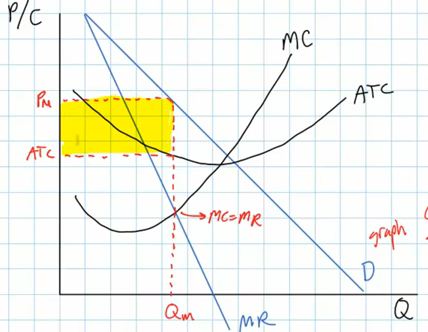
So, if this monopolist did not price discriminate they would
produce quantity Qm and charge price Pm. (They will produce the
quantity where MR=MC.) ME: and at Qm, P > MC so the
monopolist is not allocatively efficient.
PRICE DISCRIMINATION: But notice that the demand curve goes
above Pm, meaning that there are customers willing to pay more
than Pm. What would happen if the monopolist could charge these
customers more since they are willing to pay more? What happens
is: if the monopolist can charge each customer the highest
price that they are willing to pay, then MR will be the same as
price (or demand). D = MR or P = MR
So, what quantity will the perfectly price discriminating
monopolist produce to maximize profits? This is always where
MC=MR. Always.
On the graph, if P = MR then MR = MC where P = MC. You
should remember that this is the formula used to find
allocative efficiency (the socially optimal quantity)
Results of perfect price discrimination:
- more will be produced than a single-price monopolist
(Qp=MC on the graph below)
- some consumers will pay higher prices than they would if
there was no price discrimination (Pm), but other consumers
will pay lower prices
- profits will be greater (the blue plus the yellow areas
on the graph below)
- AND MOST IMPORTANTLY the perfectly price discriminating
monopolist will produce the allocatively efficient quantity!
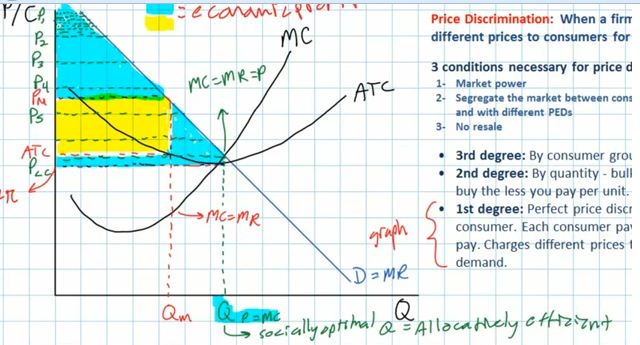
Conclusion:
- 1st degree price discrimination is almost impossible and
therefore very uncommon.
- 2nd and 3rd degree price discrimination are more
common
- but, 2nd and 3rd degree price discrimination do not
achieve the same increase in output as perfect price
discrimination and therefore do not achieve the same level
of allocative efficiency, but they are still better than a
single-price monopolist.
- effects:
- more is produced
- consumer surplus is transferred to the producers in
the form of higher revenues and profits
- Is price discrimination good for society? it depends:
- YES - it is better for the monopolist because they
get higher profits
- YES - it does improve allocative efficiency
- NO - if you are one of the customers who has to
pay an even higher price
- YES - if you are one of the customers who gets the
product at a lower price, and if there were no price
discrimination, you would not get the product at
all
Natural Monopoly and the need for Government Regulation
http://www.econclassroom.com/?p=3115
What is a "Natural Monopoly"?
- Monopoly where the long run ATC curve has economies of scale
over a very large range of output
- You can identify the graph of a natural monopoly because
the demand (D) curve crosses the ATC curve when the ATC is still
downward sloping
- this means that one very large company can produce every thing
that is demanded AT AT LOWER AVERAGE COST than if there were
several competing firms
- Examples:
- providing water to homes in a city
- electrical utilities
- natural gas
- If there were many companies each serving only a few customers
the ATC (costs per unit of output) would be higher
- it would make more sense to have only one company provide the
product because then the costs per unit (ATC) would be lower. That
is why this is called a "natural" monopoly.
- this is because there are very high fixed costs (TFC). Think
of all the costs of running water pipes to every house in a city.
These are all fixed costs. And since the TFC are very very high,
then the TC will be very high, and the only way to get ATC to be
low is to have a large amount of output (Q)
- ATC = TC / Q
- if TC are very high because of very high TFC then:
- ATC is high if: ATC = high TC / low Q
- but, ATC would be low if : ATC = high TC / large Q
Compare graphs:
- graph of a regular monopoly
- graph of a natural monopoly (EoS - Economies of Scale)
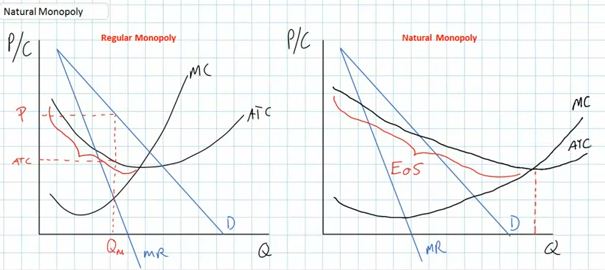
So, Society is better off (lower costs) if only one firm produces
the product, BUT:
- what will a profit maximizing monopolist do is such a
case?
- they would produce the profit maximizing quantity, where MR =
MC
- and this is NOT the allocatively efficient quantity
- like other monopolists, a natural monopolist will charge a
higher price (Pm) and produce a lower quantity (Qpm) than the
socially optimum (alloc. eff.) price of Pso and quantity of
Qso
- Result: allocative inefficiency; an underallocation of
resources
- ME: so WHAT WE GET (Qpm) is less than WHAT WE WANT (Qso)
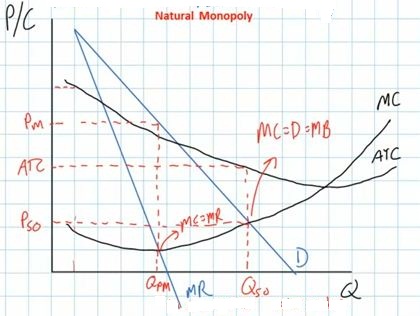
To really benefit society, natural monopolies need to be regulated
by the government
- This means that the government should use price controls and
subsidies to achieve allocative efficiency, Qso
- But what price should the government select?
- if the government puts on a price ceiling at the
allocatively efficient price of Pso
- the monopolist would then produce the allocatively
efficient quantity of Qso because the ceiling price becomes the
firm's MR and then MR = MC at Qso
- BUT, we can see that at Qso the ceiling price is less than
the ATC and the monopoly would be earning losses equal to the
blue rectangle on the graph below
- in the long run, businesses cannot operate at a loss and
they will go out of business. This would not be good for
society.
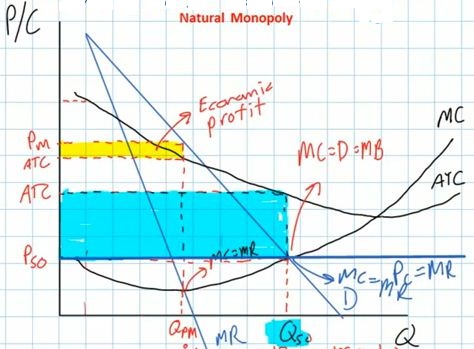
- What can the government do to prevent natural monopolies from
going out of business because to the price ceiling?
- they can use BOTH a price ceiling AND a subsidy to help the
monopoly produce the socially optimum quantity.
- ME: our textbook does NOT use the subsidy graph shown in
the video lecture (see below)
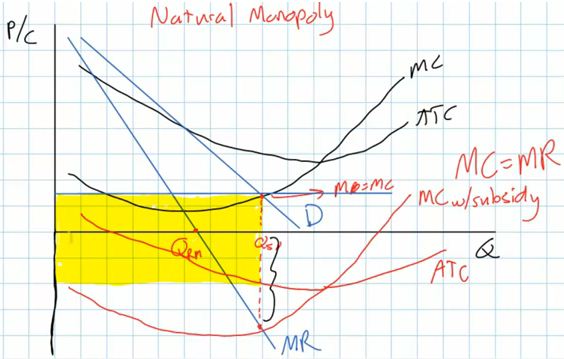
- ME: our textbook says that there are two solutions to the
problem of natural monopolies earning a loss at the
allocatively efficient price:
- provide a subsidy to cover their losses
- but this may be politically unpopular. Would you
support higher taxes to give money to Commonwealth Edison
electric company?
- the other solution that is used a lot in the united
states is AC pricing, where the government does not set a
price ceiling at the allocatively efficient price (Pso), but
rather they put the price ceiling at a prise where D=ATC
(where the demand curve crosses the ATC curve).
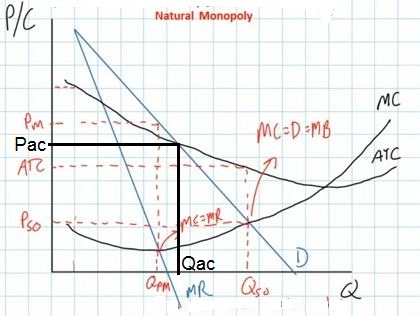
- If the price is Pac then the firm will produce Qac
- is the allocative efficient? NO, but it is closer to
Qso
- will the firms earn profits or losses? They will earn
normal profits (profits = zero) and they will be able to
stay in business. (Remember: economic costs include the
explicit costs AND the implicit cost which means that
investors are earning a return on their investment
approximately equal to their next best alternative.)






